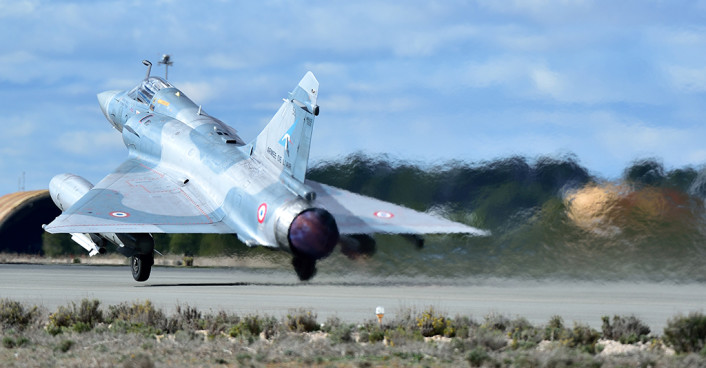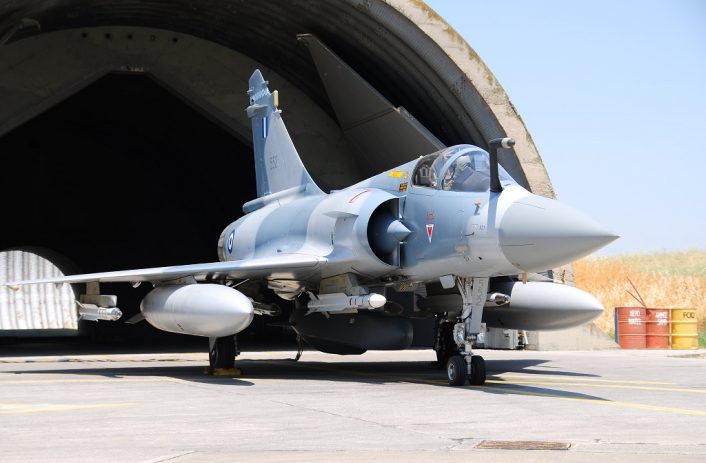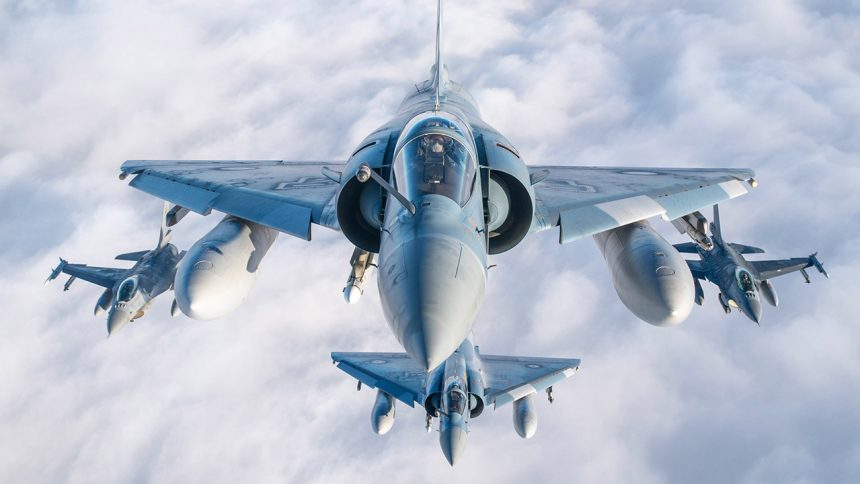Macron has announced plans to supply Mirage 2000-5 fighters to Ukraine and facilitate the training of Ukrainian fighter pilots in France.
An unspecified number of Dassault Mirage 2000-5 fighters is set to be transferred to Ukraine. This is what French President Macron said in a live interview with French TV stations. Macron disclosed an upcoming collaboration with Ukraine, highlighting the transfer of Mirage 2000-5 fighter jets and the training of Ukrainian pilots in France.
The announcement came at the end of a day of commemorations of the D-Day landings on June 6, 1944, attended by Ukrainian President Voldymyr Zelensky.
It’s not clear yet how many aircraft Paris wants to transfer to Kyiv nor is the exact timeline, although Macron said France will give “the equivalent of what other nations give.”
Integrating the Mirage 2000-5
The way the aircraft integrates with the Ukrainian Air Force operations and logistics is also to be seen. Integration of a new type requires careful planning and coordination as several challenges must be considered.
First of all training: pilots and maintenance crews need to undergo extensive training to familiarize themselves with the new aircraft’s systems, avionics, weapons, sensors and procedures. This training can be time-consuming and costly, requiring adjustments to existing training programs or the development of new ones. Considering that part of the training of a group of Ukrainian pilots is already done in France, the problem might be mitigated. Nevertheless, it will take some time before the pilots can exploit the Mirage 2000-5 at its best.

Most probably, the new aircraft doesn’t require modifications to existing infrastructure, such as hangars, maintenance facilities, but will probably need to be integrated in the existing supply chains, to accommodate its unique specifications and maintenance requirements. Integration into existing command and control systems and logistical support networks should not present challenges.
Introducing a new aircraft often entails establishing or modifying supply chains for spare parts, maintenance equipment, and specialized tools. Ensuring a steady supply of spare parts and support equipment is crucial for maintaining operational readiness and minimizing downtime. France is probably going to support the Ukrainian Air Force with plenty of spare parts and this might not be a big issue.
Integration of the new aircraft into existing operational structures and tactics may require adjustments to ensure interoperability with other aircraft types in the fleet. This includes compatibility with communication systems, joint mission planning, and cooperative engagement capabilities. This should not be a problem, considering that the Ukrainian Air Force has already been able to integrate NATO weapons systems onto Soviet/Russian types (like the Su-27 and MiG-29).
That being said, it’s also worth noting that new aircraft’s onboard systems, including sensors, avionics, and weapon systems, will all bring with them management and configuration software that will need to be tested, learned and then used on the field.

In terms of value, neither the Mirage 2000s nor the F-16s will be real game changers in the air war over Ukraine, even though they will certainly help, bringing to the aerial battlefield another 4th gen. multirole aircraft with a good maneuverability and agility, fairly modern avionics and sensors, including radar systems and electronic warfare suites, to enhance its situational awareness and combat capabilities, and the ability to carry a wide range of air-to-air and air-to-ground weapons, including missiles, bombs, and rockets.
As much as I love the Mirage 2000-5, with Mica it offers limited air defence options for Ukraine in the face of overlapping Russian SAM and R-37M toting fighter threat picture. No more than F-16, at least.
Ukr brigade training in France is more useful! https://t.co/KsPOjq5UbB
— Justin Bronk (@Justin_Br0nk) June 6, 2024
Training of Ukrainian pilots already underway
A group of junior Ukrainian Air Force pilots, fresh from completing Elementary Flight Training in the UK, has swiftly transitioned to training on Alpha Jet trainers in France. These pilots, from the 2023 class, have limited flight experience but are already immersed in learning the intricacies of aerial combat.
Reports from late April, revealed that ten Ukrainian pilots are currently undergoing training at a French airbase in the southwest region. Their curriculum includes mastering the fundamental principles of aerial combat, a crucial component as Ukraine prepares to integrate 45 F-16s into its air force inventory later this summer.
Following the green light from the United States last autumn, several nations, including the Netherlands, Denmark, and Romania, have stepped up to assist in the training of Ukrainian F-16 pilots. Presently, a dozen Ukrainian aviators are undergoing intensive training programs across Denmark, Britain, and the US, with the goal of achieving combat readiness by the upcoming summer season.
The commencement of training in France was officially announced on April 12, 2024, by French Defense Minister Sébastien Lecornu. He revealed that prospective Ukrainian fighter pilots slated to operate American F-16 aircraft would commence their training regimen in the southern regions of France under the guidance of the French Air Force.
Handpicked by Ukraine’s General Staff, some of these pilots are concurrently honing their English language proficiency in the UK, recognizing its paramount importance for NATO-affiliated pilots, alongside gaining foundational knowledge in aeronautics. Meanwhile, others, possessing prior experience in civilian aviation or training on Ukraine’s L-39 trainer jets, are stationed in southwestern France, actively engaging in aerial combat instruction, as highlighted by Lecornu.








